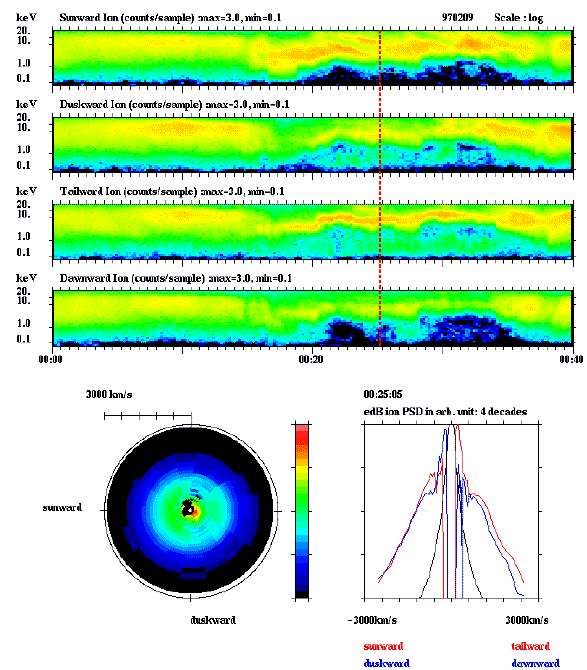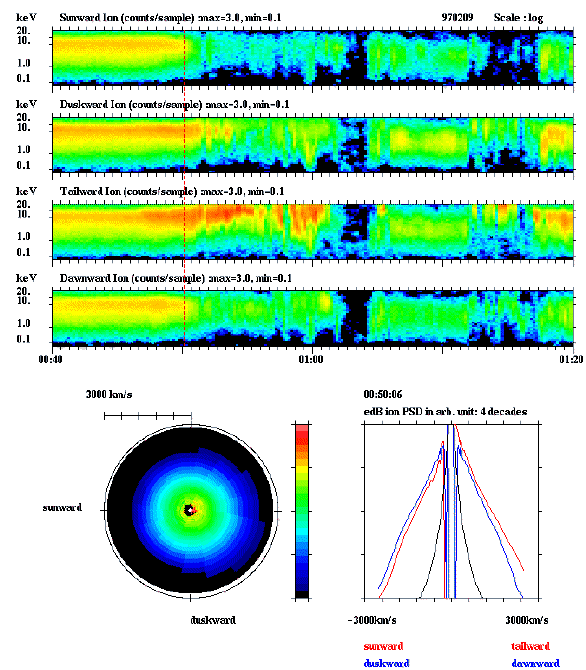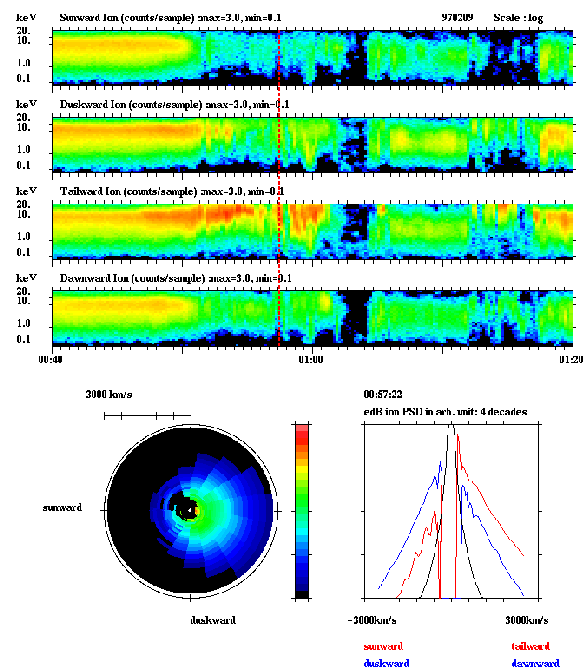Reconnection during the February
8-9, 1997 substorm period
Two intervals of geomagnetic activity were observed
in the period between 18 UT on February 8 and 04 UT on February 9. In both
instances activity in the tail started with tailward flows, followed by
a reversal to earthward flows.
The geomagnetic activity observed on February
9, 1997 occurred during a period of strong pulsation activity in the entire
magnetosphere. Pulsations started with substorm activity between 19 and
22 UT on February 8 and extended into February 9.
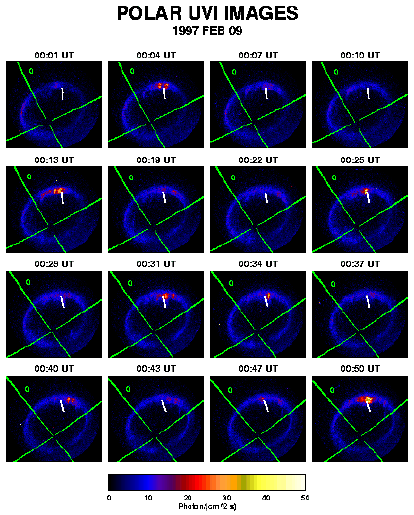
Intermittent geomagnetic activity was observed during the entire period,
which was characterized by an interplanetary magnetic field that alternated
its orientation between Bz=+5 nT and Bz=-5 nT. We will concentrate our
analysis on the 0000-0400 UT interval of February 9, where there is POLAR
UVI and VIS coverage and Sondrestrom convection measurements throughout.
Auroral activity detected by POLAR's UVI and VIS imagers during the first
substorm period extended over 8 hours local time. By contrast, the second
substorm period was concentrated over a smaller sector around western Greenland.
Multiple auroral intensifications ocurred between 00 and 0050 UT on February
9. UVI shows intensifications at 0004, 0013, 0025, 0031, and 0040 UT. None
led to a full breakup. The first intensification that evolved into a full
breakup started at 0050 UT. (Get a postscript image
here.)
Interball Tail was in the northern dusk
magnetosheath (-4.6, 19.6, 19.5) and IMP 8 was in the southern morning
lobe (-27.2, 5.3, -18.9). Wind was in the solar wind at XGSM=200
Re, YGSM=10 Re, and
ZGSM=-15 Re. Thus, given an
average solar wind bulk speed of 550 km/s, there was a travel time of 40
min between Wind and the dayside magnetopause.
Convection and particle distribution evolution
A convection enhancement was measured by the Sondrestrom radar during the
scan centered at 0020 UT on February 9, as can be seen in the figure below.
The enhancement progressed poleward and was detected
in the full range of latitudes sampled by the radar scan centered at 0030
UT.
The enhanced earthward convection was embedded in
the 0015-0035 UT period where Geotail's Low Energy Particle (LEP) detector
observed a net earthward ion flow, as shown by the moment
calculations. Phase space density ion measurements from LEP, however,
reveal that the ion plasma population was composed of counterstreaming
components with the earthward population having higher average energy than
the tailward population.
Furthermore, the plasma "beta" parameter was of order 0.25. The bidirectionality
of the ion flows in combination with the observed value of beta suggest
that Geotail was in the plasma sheet boundary layer and that it observed
ions ejected from the distant neutral line and ions bouncing back from
their ionospheric mirror points. Furthermore, the simultaneity of the PSBL
flows and the ionospheric convection enhancement indicate that distant
tail reconnection started at 0015 UT in the Geotail meridian. Ionospheric
convection was very weak at all latitudes covered by the radar scan in
the period between ~0130 and ~0200 UT.
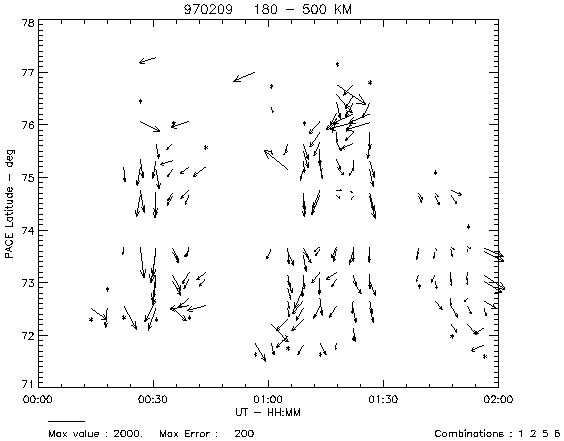 |
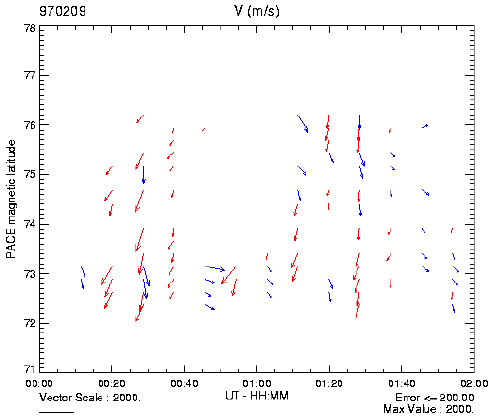 |
| Convection calculated from a combination of elevation scans |
Convection calculated from single elevation scans |
At this time, IMP 8 detected the start of a monotonic decrease
in magnetic flux. It lasted at least until IMP 8 crossed the high-latitude
magnetopause at 0205 UT. The decrease in the magnetic field strength could
have been due to either one of three effects acting alternatively or cooperatively:
i) the excursion of the spacecraft into the plasma mantle due to flapping
of the tail; ii) a decrease in the lobe field strength due to magnetotail
magnetic flux unloading; iii) a change in the solar wind flow into a more
northward orientation that made IMP 8 travel into the plasma mantle. The
excursion into the weaker field occurring in a monotonic fashion and for
a period lasting much longer than the flapping period seems to rule out
the first possibility. The second mechanism would be consistent with the
occurrence of clearly indicates that even if IMP 8 entered the mantle it
was because the magnetic flux in the tail was decreasing. Therefore, simultaneous
ionospheric convection enhancement and tail lobe unloading suggest that
lobe reconnection occurred at that time.
A period of tailward flow was observed by LEP
starting at 00 47 UT. Geotail was located at XGSM=-29.1,
YGSM=5.8, ZGSM=0.1
Re at 00 UT on February 9. Geotail's location at that time places the spacecraft's
footpoint a half hour local time eastward of the magnetic meridian where
the auroral intensification was most intense. Although initially mostly
magnetic field-aligned, the convective component became apparent later
and continued until ~0125 UT, as shown by the moment
calculations.
The intensification of the polewardmost arc coincided
with a period of significant decrease in the equatorward convection, between
~0135 and ~0205 UT. At the end of the low convection period, STF measured
a new intensification in the equatorward convection that coincided with
the intensification of an arc that was equatorward of the polar cap boundary.
Ion and electron space distribution measurements by Geotail for the
period preceding the first auroral intensification.
Energetic electron injection was apparent in LANL 1990-095, whose footpoint
is very close to Narssarssuarq (see Plate #), at 0104 UT. It lasted only
until 0130 UT and was non-negligible only in the two lowest energy channels,
namely 50-75 and 75-105 keV. Therefore, particle injection lagged the expansion
onset by at least 14 min.Notice that the electron flux enhancement was
not preceded by a flux depletion that characterizes most growth phase intervals.



